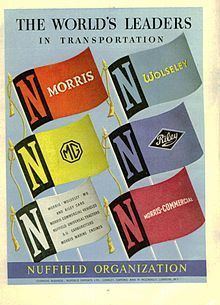Formation 1943 (1943) Headquarters Oxford, United Kingdom | Founded 1936 | |
 | ||
Predecessor The Morris Organizations Successor British Motor Corporation Services Health and automotive industry Leader William Morris, Viscount Nuffield | ||
Nuffield Organization was the unincorporated umbrella-name or promotional name used for the charitable and commercial interests of owner and donor, William Morris, 1st Viscount Nuffield. The name was assumed following Nuffield's gift made to form his Nuffield Foundation in 1943, it linked his business interests to his existing very generous philanthropy. The same enterprises had previously been referred to as the Morris Organizations and at first described itself as The Nuffield Organization, A Cornerstone of Britain's Industrial Structure.
Contents
Productive members of the Nuffield Organization
The productive businesses were owned by Morris Motors Limited and this corporate structure appears to have been retained until the formation of British Leyland in 1968.
In 1945 the principal businesses among them were:Morris-Austin merger
An agreement was reached between Morris and Austin Motor Company in October 1948 amounting to amalgamation in everything but financial structure. The terms included the constant interchange of information on production methods, research, design, buying and almost every other aspect of their work. It also envisaged the pooling of factory resources. In July 1949 Morris and Austin announced the end of their scheme, no further steps would be taken to pool production resources and no merger of any kind was contemplated.
"Nuffield and Austin broke off arrangements for the exchange of confidential information in 1949 following the revival of long-standing hostilities between their chief executives and the Labour Party's decision not to include the industry in its plans for future nationalisation." Leonard Lord, chief of Austin, had been with Morris from 1923 to 1936, the last four years as Morris's chief executive. They had parted on extremely bad terms.
The Motoring Correspondent of The Times said the two concerns were fundamentally different in their structure. The Nuffield Organization under the control of Morris Motors made: three Morris models with Wolseley (two), Riley (two), MG (two) as well as Morris Commercial trucks, Nuffield Universal tractors and marine engines. The main factory was at Cowley, Oxford, there were more at Birmingham, Coventry and Abingdon. The Austin business, Austin of England, was highly concentrated both in its huge Longbridge factory at Birmingham and in its products: six Austin car models, Austin trucks and marine engines and battery electric vehicles.
The nine different cars made by Nuffield using six engines and five (and a half) car bodies of which the "specialist" three were obsolescent, the rest very closely related if not identical.
The specialist MGs and Rileys were to be the last of their separate-chassis line — except for the MG Midget TF and MGA, which latter lasted until the monocoque MG MGB of 1962. The bigger Morris and Wolseley cars shared an identical monocoque structure aft of their engine compartments and almost all mechanicals, the Minor's structure was a smaller version of the same monocoque design.
However, on Friday 23 November 1951 a joint statement announced plans for a merger. The two companies would retain their separate identities and would not produce the same models. Forty years later the merger was recognised to have been a political decision in the face of American competition and the absence of heirs for either Morris or Austin.
The British Motor Corporation Limited
Morris Motors Limited merged with The Austin Motor Company Limited in The British Motor Corporation Limited in 1952. The two groups were very evenly matched, not only in financial terms, each had produced and sold in the previous year an almost identical number of vehicles.
By an agreement between the Nuffield and Austin groups announced in November 1951 a new company was incorporated in February 1952 and named The British Motor Corporation Limited. On 29 February 1952 it offered to buy all the shares in Morris Motors Limited giving in exchange shares in BMC.
Holders of the Ordinary shares in either Morris or Austin received the same number of new Ordinary shares in BMC
Holders of Preferred shares, because of the four different classes in Austin's capital received various apportionments of new 5% Cumulative Preference shares related to their market valuations.
On 10 April 1952 it was announced that sufficient acceptances had been received to satisfy the conditions of the offer of 29 February.
The first published balance sheet of BMC, 31 July 1952 showed:
On 8 September 1952 The British Motor Corporation advertised that it included:
as well as:
Continuing identity
The Nuffield Organization and its members retained their individual identities until the formation of British Leyland
